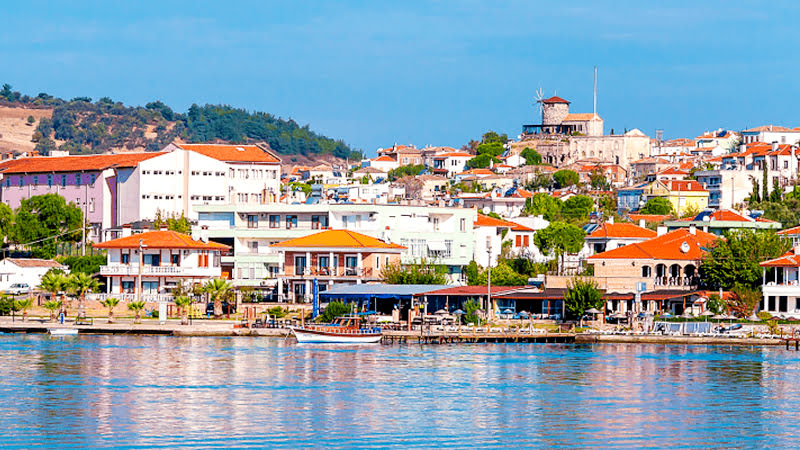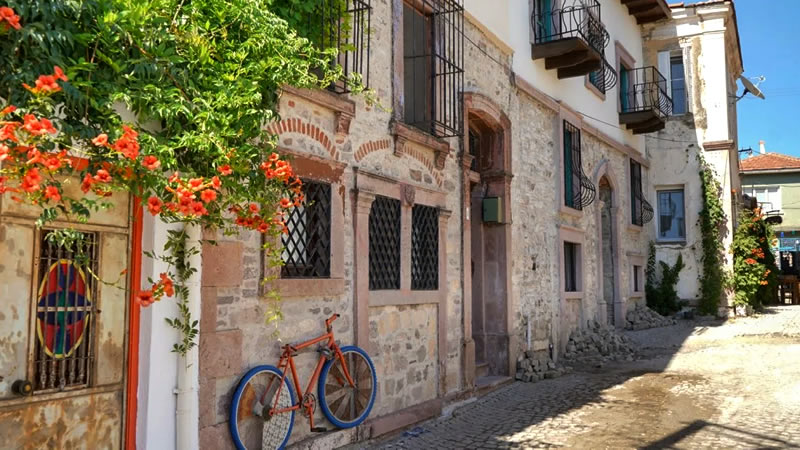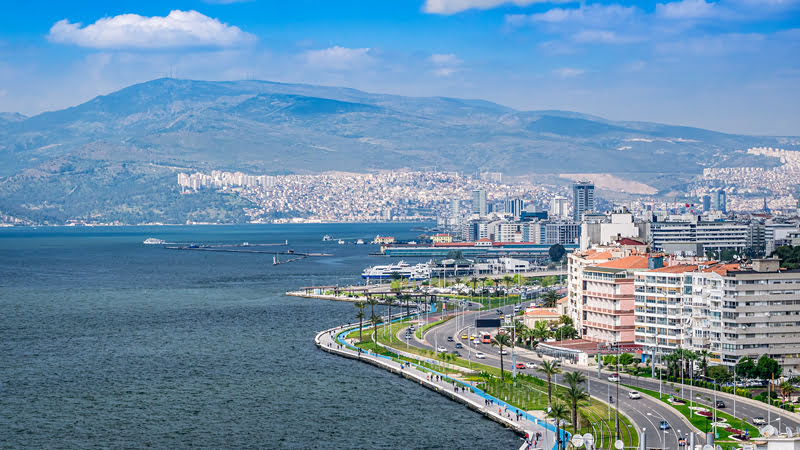Ayvalik Cunda Island A Place of Natural Beauty and Legends

Ayvalik is known as a paradise vacation spot along the stunning shores of the Aegean Sea. The area captivates visitors with its historical charm, natural beauty, and cultural richness. However, what truly makes Ayvalik special is the islands surrounding it. The Ayvalik Islands, with their enchanting landscapes, crystal-clear coves, and mystical legends, form one of the Aegean's most unique corners. In this article, we’ll explore the natural beauty, history, and legends surrounding the islands around Ayvalik.
Ayvalik, a port town on Türkiye's western coast opening into the Aegean Sea, is surrounded by numerous small and large islands. The most popular of these is Cunda Island, also known as Alibey Island. These two names represent different eras of the island's history. Cunda, the region's largest island, offers a peaceful and exploratory vacation with its historical fabric and natural beauty.
Cunda Island is connected to Ayvalik by road. It’s easily accessible, as you can cross over to the island via the Cunda Bridge, Türkiye's first strait bridge. This bridge provides a preview of Ayvalik's and its surrounding islands' natural beauty as you cross. Additionally, there are ferry services from Ayvalik center to Cunda, which are particularly popular during the summer tourist season. These ferry trips provide a great opportunity to enjoy the blue waters of the Aegean. With car rental services in Ayvalik, exploring this area in more detail becomes possible.
The history of Cunda Island dates back to ancient times, with various civilizations inhabiting the island throughout history. Known as "Nesos" in ancient times, Cunda became a significant trading hub during the Byzantine Empire. In the Ottoman period, the island was referred to as "Cunda" or "Moshonisia." The name "Alibey Island" was given during the Republic era, in honor of Lieutenant Colonel Ali Cetinkaya, the commander of the first unit to resist the Greek occupation during the War of Independence. He became a symbol of resistance in the area, and the island was named after him.
During the Ottoman period, Cunda was predominantly inhabited by a Greek population. Churches and monasteries built in this period form the island’s rich historical texture. One of Cunda's most significant historical structures is the Taksiyarhis Church. Built in 1873, this church served as a primary worship place for the Greek Orthodox community. Today, it has been restored and opened as a museum, with its high ceilings, elegant decorations, and frescoes offering deep traces of the island's history.
Cunda Island is famous not only for its historical richness but also for its natural beauty. The coves on the island's east and west coasts, with their clear waters and tranquil beaches, are favorites among those seeking peace. Patriça Bay is one of the most popular among these coves. It’s an ideal spot for nature walks, swimming in its clear waters, and enjoying the silence. Additionally, Lovers' Hill on the island’s western side is a perfect place to watch one of Cunda's most beautiful sunsets.
The legends accompanying Cunda Island’s natural beauty add to its charm. The most famous of these legends is the belief that Poseidon and the sea god Triton were born here. In ancient Greek mythology, Cunda is associated with sea gods, and its waters are believed to have healing powers. Additionally, the island is renowned for its olive groves, which also have a mythical origin. According to legend, the island's olive trees have been under the protection of the gods since ancient times and are considered sacred.
Cunda Island offers a journey filled with historical and natural beauty. One of its most striking structures, Taksiyarhis Church, is an architectural masterpiece. Now serving as the Rahmi M. Koc Museum, this historical church is a vital part of the island's cultural heritage. It features exhibitions related to maritime history, vehicles, and objects from past eras, offering visitors a rich insight into the island's past.
Another prominent structure on Cunda Island is the Despot House. Built in the late 19th century, it once served as the residence of a wealthy Greek merchant. Today, it remains one of Cunda's most important historical structures. Walking through the island's streets, you can discover many similar historic buildings. Cunda’s stone houses, narrow streets, and paths surrounded by olive groves take visitors on a journey into the past.
Cunda Island offers a wide range of accommodation options. Boutique hotels converted from historical stone houses are a fantastic choice for those wanting to experience the island’s spirit. These hotels provide a comfortable stay while allowing visitors to feel the island’s historic atmosphere. For those preferring to stay in Ayvalik, there are many options available; hotels and pensions in the town center make a great starting point for exploring the area.
Getting to Cunda Island is very easy. Ferries from Ayvalik are highly popular during the summer and get you to the island quickly. However, to fully enjoy the island, renting a car in Ayvalik is a practical choice. This way, you can easily explore every corner of the island and discover its hidden beauties. Additionally, Ayvalik transfer services provide a comfortable option for reaching the island and can be an ideal solution for those wanting to explore the area.
Ayvalik Islands await visitors as a hidden paradise in the blue waters of the Aegean. Cunda Island is the heart of this paradise. With its historical texture, natural beauty, and mythological legends, Cunda offers new wonders at every step. When visiting Ayvalik, you can make your transportation easier with reliable companies like iZMiRCAR Car Rental and seize the opportunity to explore every corner of this unique island. Cunda is not just an island; it is a treasure of history and nature that will remain in your memory. Enjoy this hidden paradise of the Aegean there's a story waiting in every corner.
An Overview of the Ayvalik Islands and Cunda Island
Ayvalik, a port town on Türkiye's western coast opening into the Aegean Sea, is surrounded by numerous small and large islands. The most popular of these is Cunda Island, also known as Alibey Island. These two names represent different eras of the island's history. Cunda, the region's largest island, offers a peaceful and exploratory vacation with its historical fabric and natural beauty.
Cunda Island is connected to Ayvalik by road. It’s easily accessible, as you can cross over to the island via the Cunda Bridge, Türkiye's first strait bridge. This bridge provides a preview of Ayvalik's and its surrounding islands' natural beauty as you cross. Additionally, there are ferry services from Ayvalik center to Cunda, which are particularly popular during the summer tourist season. These ferry trips provide a great opportunity to enjoy the blue waters of the Aegean. With car rental services in Ayvalik, exploring this area in more detail becomes possible.
The History and Cultural Heritage of Cunda Island
The history of Cunda Island dates back to ancient times, with various civilizations inhabiting the island throughout history. Known as "Nesos" in ancient times, Cunda became a significant trading hub during the Byzantine Empire. In the Ottoman period, the island was referred to as "Cunda" or "Moshonisia." The name "Alibey Island" was given during the Republic era, in honor of Lieutenant Colonel Ali Cetinkaya, the commander of the first unit to resist the Greek occupation during the War of Independence. He became a symbol of resistance in the area, and the island was named after him.
During the Ottoman period, Cunda was predominantly inhabited by a Greek population. Churches and monasteries built in this period form the island’s rich historical texture. One of Cunda's most significant historical structures is the Taksiyarhis Church. Built in 1873, this church served as a primary worship place for the Greek Orthodox community. Today, it has been restored and opened as a museum, with its high ceilings, elegant decorations, and frescoes offering deep traces of the island's history.
Cunda Island: Natural Beauty and Legends
Cunda Island is famous not only for its historical richness but also for its natural beauty. The coves on the island's east and west coasts, with their clear waters and tranquil beaches, are favorites among those seeking peace. Patriça Bay is one of the most popular among these coves. It’s an ideal spot for nature walks, swimming in its clear waters, and enjoying the silence. Additionally, Lovers' Hill on the island’s western side is a perfect place to watch one of Cunda's most beautiful sunsets.
The legends accompanying Cunda Island’s natural beauty add to its charm. The most famous of these legends is the belief that Poseidon and the sea god Triton were born here. In ancient Greek mythology, Cunda is associated with sea gods, and its waters are believed to have healing powers. Additionally, the island is renowned for its olive groves, which also have a mythical origin. According to legend, the island's olive trees have been under the protection of the gods since ancient times and are considered sacred.
Places to Visit on Cunda Island
Cunda Island offers a journey filled with historical and natural beauty. One of its most striking structures, Taksiyarhis Church, is an architectural masterpiece. Now serving as the Rahmi M. Koc Museum, this historical church is a vital part of the island's cultural heritage. It features exhibitions related to maritime history, vehicles, and objects from past eras, offering visitors a rich insight into the island's past.
Another prominent structure on Cunda Island is the Despot House. Built in the late 19th century, it once served as the residence of a wealthy Greek merchant. Today, it remains one of Cunda's most important historical structures. Walking through the island's streets, you can discover many similar historic buildings. Cunda’s stone houses, narrow streets, and paths surrounded by olive groves take visitors on a journey into the past.
Accommodation and Transportation on Cunda Island
Cunda Island offers a wide range of accommodation options. Boutique hotels converted from historical stone houses are a fantastic choice for those wanting to experience the island’s spirit. These hotels provide a comfortable stay while allowing visitors to feel the island’s historic atmosphere. For those preferring to stay in Ayvalik, there are many options available; hotels and pensions in the town center make a great starting point for exploring the area.
Getting to Cunda Island is very easy. Ferries from Ayvalik are highly popular during the summer and get you to the island quickly. However, to fully enjoy the island, renting a car in Ayvalik is a practical choice. This way, you can easily explore every corner of the island and discover its hidden beauties. Additionally, Ayvalik transfer services provide a comfortable option for reaching the island and can be an ideal solution for those wanting to explore the area.
Ayvalik Islands await visitors as a hidden paradise in the blue waters of the Aegean. Cunda Island is the heart of this paradise. With its historical texture, natural beauty, and mythological legends, Cunda offers new wonders at every step. When visiting Ayvalik, you can make your transportation easier with reliable companies like iZMiRCAR Car Rental and seize the opportunity to explore every corner of this unique island. Cunda is not just an island; it is a treasure of history and nature that will remain in your memory. Enjoy this hidden paradise of the Aegean there's a story waiting in every corner.













































